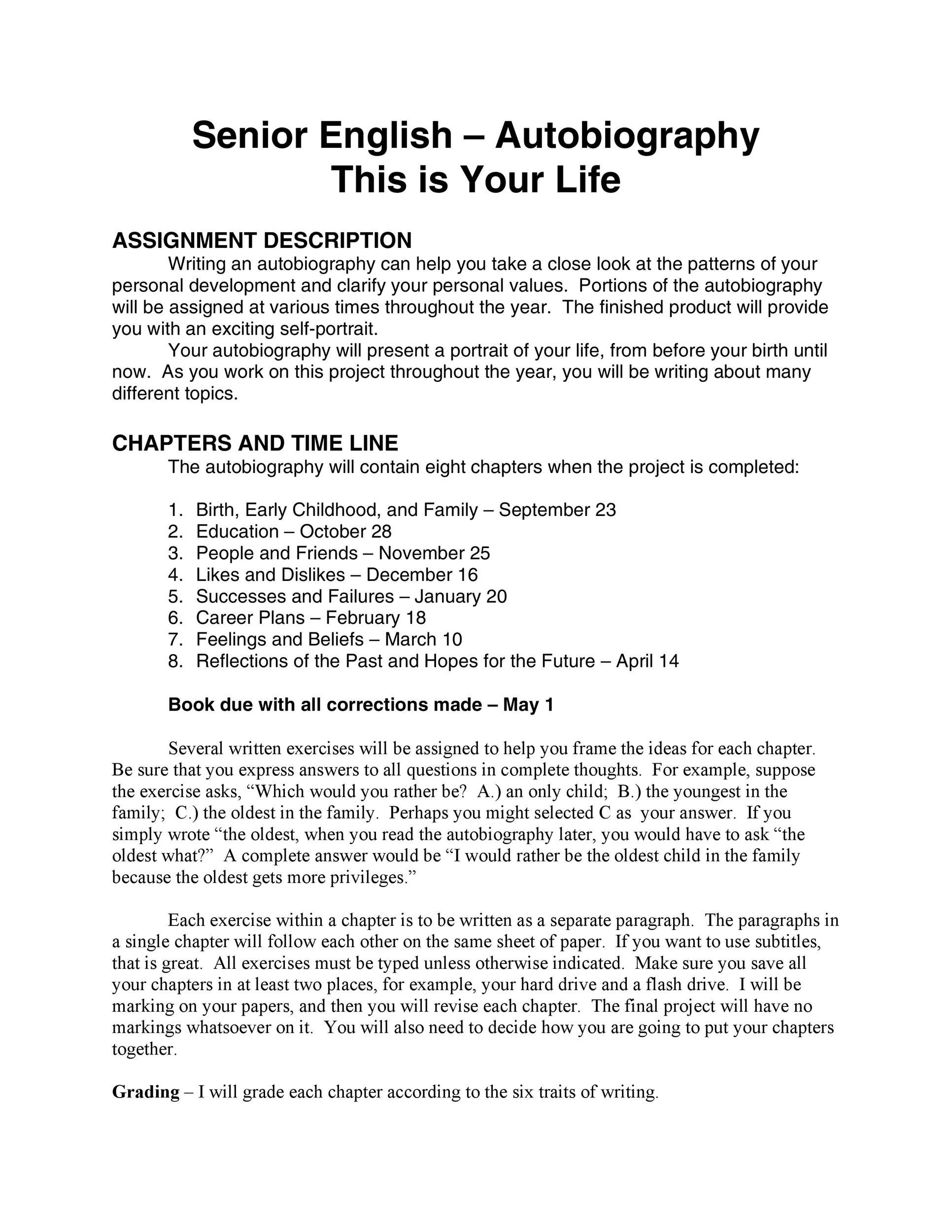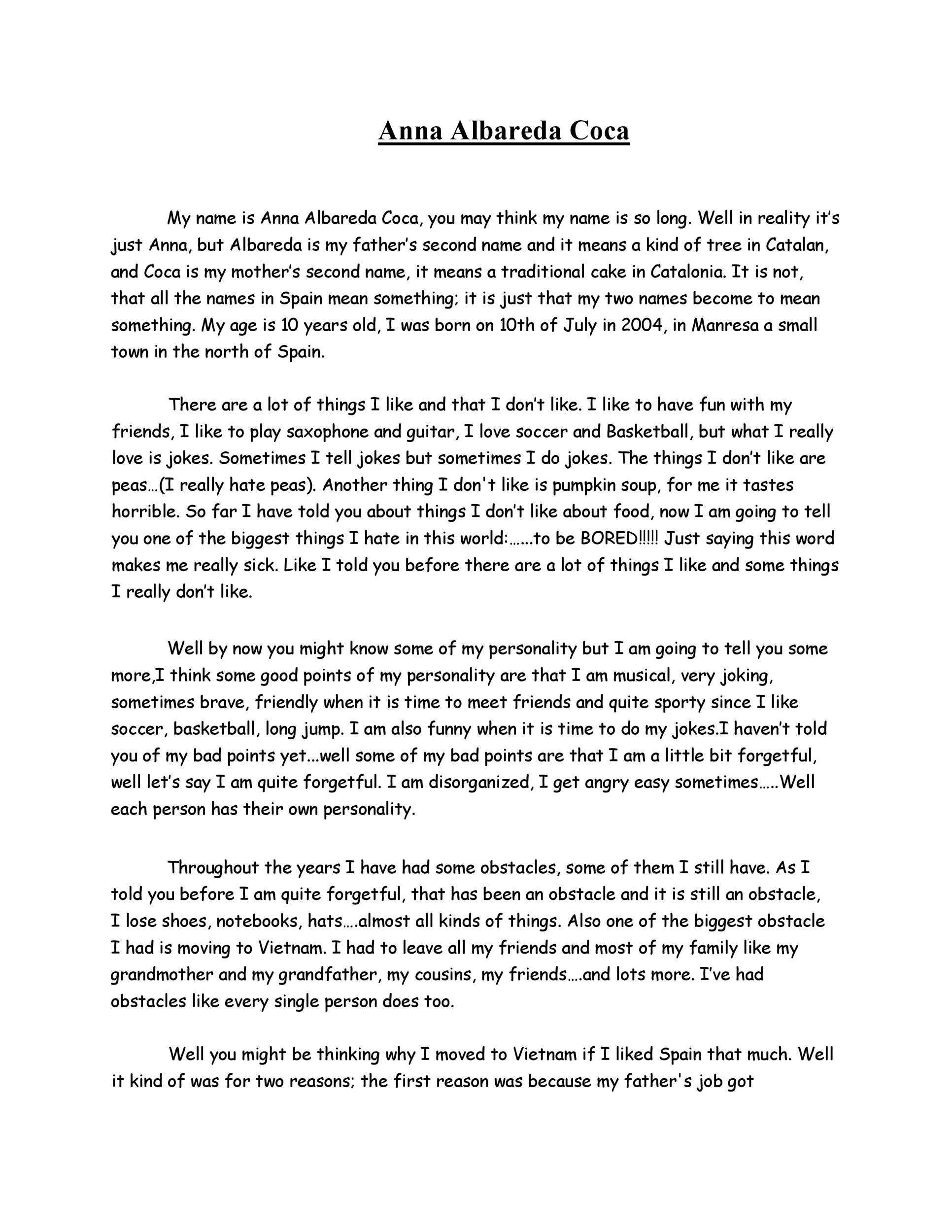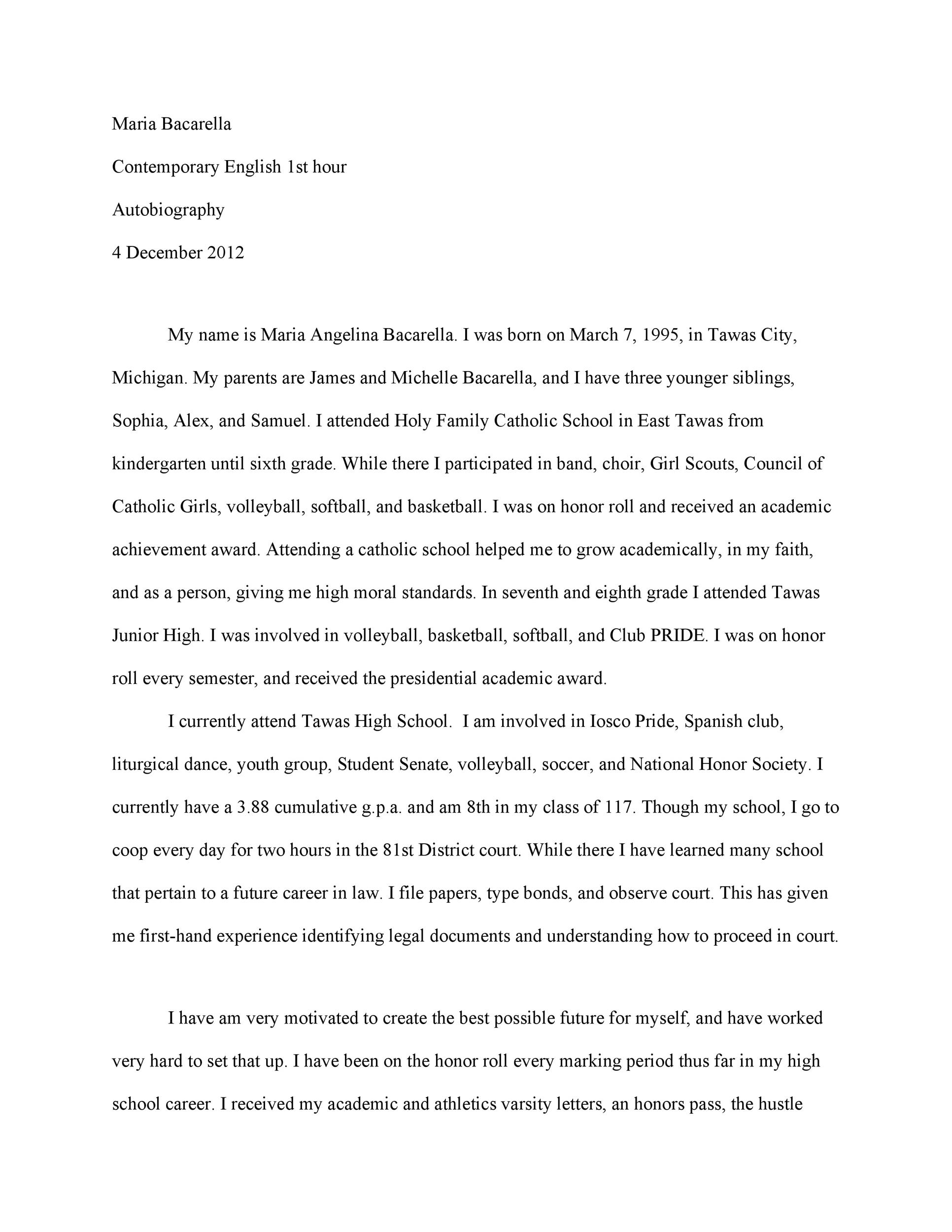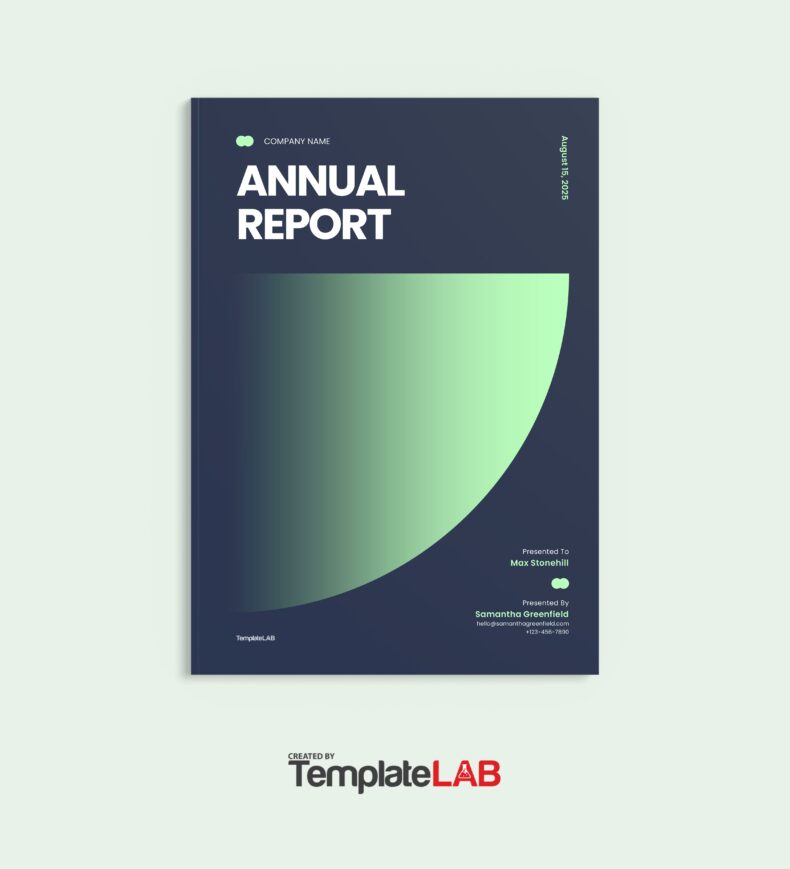Writing an autobiography template isn’t an easy undertaking. When written, there will be as many life stories as there are people. What will make an autobiographical essay stand out are the essential topics.
Those which will make it unique among the rest, sorting out the most significant events in one’s life and writing about them are difficult. There is an abundance of experiences to choose from.
Table of Contents
Fortunately, there are plenty of innovative and well-thought-out autobiography samples that are available. They can assist you in organizing your thoughts to come up with a great autobiography. These samples can save you valuable time, especially on how to start an autobiography. Check out our extra 40 biography templates
Autobiography Examples
Formats for autobiography examples
As mentioned earlier, there could be as many life stories out there as there people. Each life story is unique; no two can be the same. It will be up to the writer to make his autobiography stand out.
The presentation of ideas will be an integral factor. Using the right strategies and format to make the writer more creative are necessary. As we all know, an autobiography is an account of a person’s life and it’s written by that person. Find out a suitable autobiography example to take reference from.
The reasons for writing an autobiographical essay differ from person to person. The main point of the writer’s exercise is to convey his life events using words. Autobiography samples will make it easy for the writer to organize thoughts.
To get you started, learn first the following types of written works:
- Dramas or scripts
Usually presented on stage or screen as the venue, this type is in script formats. - Graphic novels
This new genre of novels is unique in the sense that they use drawn panels to convey a true story. Simply said, it’s a novel in comic-strip format. They tell stories through pictures and words. - Memoirs
This type limits the information you will present. It’s an account written from personal knowledge or special sources. Its main focus is on specific moments in one’s life. Those which could either are historical, religious, philosophical, adversity, coming-of-age, and more. - Personal narratives or essays
This type is shorter than a memoir. Its narratives focus on a single event in time. It expands that moment’s experience through conversations and imagery. These types are usually seen in classrooms, magazines or written by internet bloggers. - Traditional autobiographies
This type usually covers the events of the writer’s life from birth to the present moment. - Vignettes
This type covers just one particular occurrence at a time. It’s a brief evocative description, account or episode. You can even call it a lone chapter in a compilation of vignettes.
You can have it published as a complete piece of work. Bear in mind, though, that each chapter in the collection is not directly related to the others.
Autobiography Samples
How to start an autobiography
Interesting lives make for good autobiographies. When we say interesting, it means the person lived a life full of fascinating experiences. Those he can and should share with others.
A good trick when writing your autobiography example is to think of it just like any other story, a good one at that. There’s always the protagonist, a central plot, and a number of compelling characters. All these will keep the reader’s attention.
Before venturing for an autobiography sample, think of an important event in your life and build your story on that. There is a writing craft or a technique that can make your story come to life. Read on and make your writing sing!
Map out your whole life
It wouldn’t be so hard to map out your timeline; after all, you have lived it. Before anything else, conduct a study on your life. Make a timeline to ensure you will include the important details, both events, and dates.
This will provide you a basis to work on. Don’t inhibit yourself from writing down all you can recall. Don’t underestimate the importance of each event.
- Autobiographies needn’t always start with your birth
Include a brief history of your ancestors if relevant. Introducing your family’s history can make readers relate. They can understand how you evolved into who you are at this moment. - Identify your main characters
Make them interesting and compelling, either he/she be friend or foe. Be sure they help in moving the story along. Obviously, an autobiography sample will mention your parents.
Also, include your spouse, friends, and relatives. But think past your family and friends. Search for those characters that have directly influenced your life. They should play their roles in your life story. - Include the best stories
Your life is a collection of short stories and anecdotes. Each day, each struggle could be in itself a chapter. But there would be too many of them to contain in a book.
Choose the best stories you can remember that have influenced you. Begin your manuscript with these chosen stories. Weave them together to create a picture of your life. - Write using your own voice
Most people like reading autobiographies to experience what it’s like to be the writer. Being yourself when writing your story is a great way to maintain the reader’s attention.
Remember, you are writing about yourself and your life experiences. Stiff and formal writing is for college essays. It won’t and can’t totally engage your readers. - Reveal things about your life
You can reveal the truth about yourself without having to be too explicit. Write down the good as well as the bad experiences. This will make the reader feel the human side of you.
You can write about your accomplishments but you also need to write the flaws that have made you what you are. Readers should empathize with you and may even cheer for you as the story progresses. - Show your weaknesses too
You may have pitfalls in life but will still remain a protagonist. Write about your mistakes and the times that you have failed in some struggles. Writing too much about your positive side may even turn off some of your readers.
Creating your narrative
One, or perhaps the most important element of an autobiographical essay, is the plot. Not just a plot but a great one that could hold your readers spellbound. When you’ve gathered the material to work with, it’s time to create a fascinating story that would end with a climax as well as final resolutions.
Autobiographical Essay Templates
Craft your story by organizing your memoirs and anecdotes in an autobiography example. Keep in mind that these are coherent to your plot and should flow logically together. There should be a central conflict in your narrative.
It can involve an eventful experience in your life that took you years to conquer.
- Build the suspense and tension to make it interesting
Organize your plot in such as a way that every story would veer towards the conflict’s climax. Make it your goal to include anecdotes on your initial successes and failures. Readers love underdogs. Build on that. - Think about your climax
Every story will have to end as the protagonist will deal with the conflict. You have read novels and seen movies. You should know what a climax is. You should also know that it’s very important. - Also, think about the resolution
Autobiographies usually end with happy endings. If for some reason your story’s ending isn’t happy, just make sure that it’s profoundly satisfying. You might have lost the race but the wisdom you gain from the experience will be compensation enough. - Determine where to start your story
Most autobiographies start with birth and end with the present. But many successful writers have resorted to mixing up their chronology. This makes the narration more interesting. If you’re bold enough, try doing this. - Weave in your themes
Try to remember major themes in your life. Use them to link stories together by connecting the past with the now. Apart from a central conflict, there are themes that have followed us all through life.
Use these themes as often as you can to form a consistent depiction of your story. - Reflect on the content of your autobiography template
You surely have learned many lessons during the course of your life. It would be nice to relay your desires, intentions, feelings of joy and loss, and more you’ve gained in your life.
You can include these lessons intermittently throughout the story. Reflect on these important experiences and what they have meant to you. This is a great way you can add profundity to your life story. - Add structure to your book by using chapters
The use of chapters will permit you transition from talking about specific times in your life. We’ve all heard the expressions, “closed a chapter” and “opening a new chapter” in life. These are very applicable to autobiography samples and autobiography examples.
Creating and publishing your autobiography
After you’ve written everything, subject your work to several processes. Do this to make sure that its contents are true and accurate. Be sure to comply with all the rules of writing to avoid any problems that may arise later.
First, does a substance check. Second, do forms check? Here are some tips for you:
Edit your information first
- Your facts should be completely accurate
Double check or even triple if you have the time. Check the names, event descriptions, dates, and other things. Everything in your story should be accurate. Wrong facts will certainly get noticed at one time or another by people acquainted with you. - Ask permission from those you mention in your book
You may name names or quote quotes from sources. In this case, make certain they’ve granted permission. Many don’t appreciate the thought of appearing in an autobiography.
Respect that. If the character is central to the plot, describe them differently or change their names. - Go through your draft and edit if needed
After you’ve finished the initial draft, go through your life story again. Comb through it by double checking your data. Reorganize the paragraphs, passages, and characters if necessary.
Check your vocabulary and replace tedious words. Make your phrases more clear and compelling. And lastly, check your grammar and spelling. - Let other people read your work
An outside or second opinion will be necessary to make sure that your work would appeal to all. You may find passages in your book that are funny or serious but would be mundane or even offensive to others.
Present your work to as many close acquaintances and listen to their feedback. This will make sure that your thoughts will come across clearly with other people. - Hire a copy editor
The job of a copy editor is to clean up your work and make those boring parts shine. Almost all writers seek the services of copy editors.
Being a beginner, take a hint by seeking their help as well. Hire a seasoned copy editor to make sure that your book will have that professional polish. - Think of your title
Think of a title that is intriguing and attention-grabbing. A simple and short title for your autobiography can be “My Autobiography”. If you find it too direct and common, choose something more unique.
Publishing your autobiography
Some people try self-publishing their books. That means they will have their finished work printed but only for themselves. It would also be appropriate to present your work to persons you mentioned in your book.
There are companies that can handle your book design, printing, and even shipping services. But if you want to go public on publishing your autobiography, the sensible thing to do is hire a literary agent.
He will send a query letter to research agents who work frequently with autobiographies. The query will contain information about your autobiography. It will also contain information about the author and how you want to market the book.
You can also send the query letter yourself directly to the publisher and wait. Depending on your query letter, he might get interested. Don’t send them your manuscript all at once. Send it when you get a request for your manuscript.
You can also try publishing your work online. This new alternative method is increasingly getting popular. It doesn’t involve expenses for printing and shipping. Search for online publishers and send them a query letter.














































